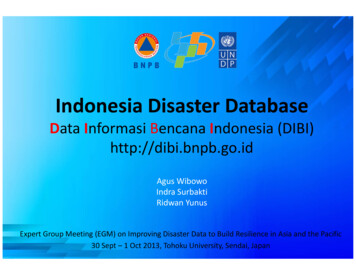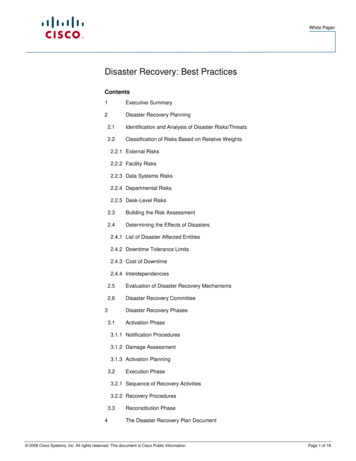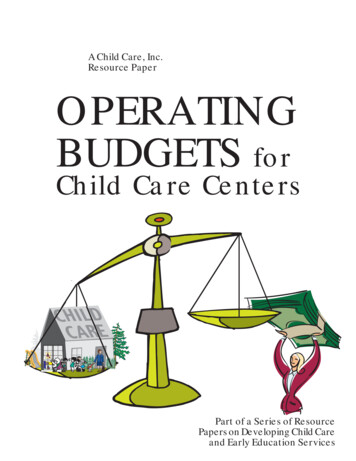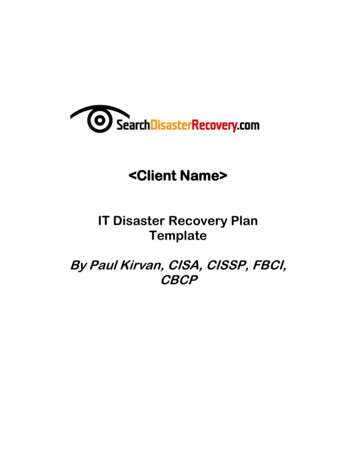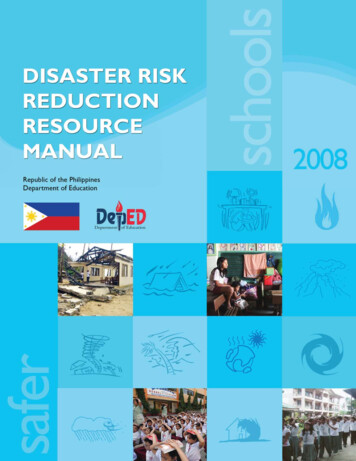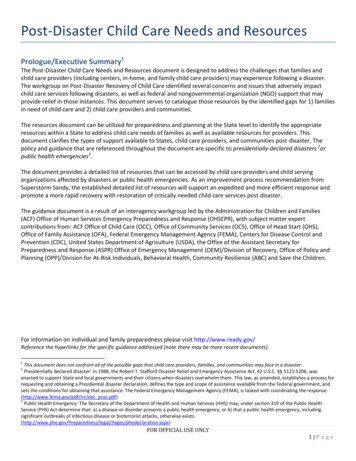
Transcription
Post-Disaster Child Care Needs and ResourcesPrologue/Executive Summary1The Post-Disaster Child Care Needs and Resources document is designed to address the challenges that families andchild care providers (including centers, in-home, and family child care providers) may experience following a disaster.The workgroup on Post-Disaster Recovery of Child Care identified several concerns and issues that adversely impactchild care services following disasters, as well as federal and nongovernmental organization (NGO) support that mayprovide relief in those instances. This document serves to catalogue those resources by the identified gaps for 1) familiesin need of child care and 2) child care providers and communities.The resources document can be utilized for preparedness and planning at the State level to identify the appropriateresources within a State to address child care needs of families as well as available resources for providers. Thisdocument clarifies the types of support available to States, child care providers, and communities post-disaster. Thepolicy and guidance that are referenced throughout the document are specific to presidentially-declared disasters 2orpublic health emergencies3.The document provides a detailed list of resources that can be accessed by child care providers and child servingorganizations affected by disasters or public health emergencies. As an improvement process recommendation fromSuperstorm Sandy, the established detailed list of resources will support an expedited and more efficient response andpromote a more rapid recovery with restoration of critically needed child care services post disaster.The guidance document is a result of an interagency workgroup led by the Administration for Children and Families(ACF) Office of Human Services Emergency Preparedness and Response (OHSEPR), with subject matter expertcontributions from: ACF Office of Child Care (OCC), Office of Community Services (OCS), Office of Head Start (OHS),Office of Family Assistance (OFA), Federal Emergency Management Agency (FEMA), Centers for Disease Control andPrevention (CDC), United States Department of Agriculture (USDA), the Office of the Assistant Secretary forPreparedness and Response (ASPR) Office of Emergency Management (OEM)/Division of Recovery, Office of Policy andPlanning (OPP)/Division for At-Risk Individuals, Behavioral Health, Community Resilience (ABC) and Save the Children.For information on individual and family preparedness please visit http://www.ready.gov/Reference the hyperlinks for the specific guidance addressed (note there may be more recent documents).1This document does not confront all of the possible gaps that child care providers, families, and communities may face in a disaster.Presidentially declared disaster: In 1988, the Robert T. Stafford Disaster Relief and Emergency Assistance Act, 42 U.S.C. §§ 5121-5206, wasenacted to support State and local governments and their citizens when disasters overwhelm them. This law, as amended, establishes a process forrequesting and obtaining a Presidential disaster declaration, defines the type and scope of assistance available from the Federal government, andsets the conditions for obtaining that assistance. The Federal Emergency Management Agency (FEMA), is tasked with coordinating the response.(http://www.fema.gov/pdf/rrr/dec proc.pdf)3Public Health Emergency: The Secretary of the Department of Health and Human Services (HHS) may, under section 319 of the Public HealthService (PHS) Act determine that: a) a disease or disorder presents a public health emergency; or b) that a public health emergency, includingsignificant outbreaks of infectious disease or bioterrorist attacks, otherwise s/phedeclaration.aspx)2FOR OFFICIAL USE ONLY1 P a g e
11 March 2016Post-Disaster Child Care Needs and Resources Table of ContentsThe workgroup on Post-Disaster Recovery of Child Care identified the following major concerns and issues that have adverselyimpacted child care services following disasters.1. Child care needs of families post-disastera)Child care and child respite care needs in the disaster relief environmenti. Immediate 24-hour child care for emergency response personnel (includes search and rescue, fire, police, hospital,etc.).ii. Temporary Respite Care in emergency congregate (ESF-6) shelters and/or Disaster Recovery Centers (DRCs).iii. Emergency Child Care.a. For families not normally participating in child care, but need care while they start the rebuilding and recoveryprocess.b. For affected communities where significant amount of child care delivery have been damaged or destroyedduring the emergency.b) Disaster impacts affecting families with childreni. Employment losses/disaster-caused economic challenges that create new barriers for affordable child careservices.ii. Displacement or relocation of families resulting in loss of pre-disaster child care provider services or loss of childcare subsidies (for example when families are relocated across state lines).iii. Disaster-caused barriers for Child Care and Development Fund (CCDF) recipient families in maintaining eligibilityand/or affording child care services, including employment losses.iv. Transportation difficulties for families resulting in the inability to use prior child care provider.2. Support for child care providers and communities a) Disaster impacts affecting child care providersNote: home-based providers are for-profit businesses and are often disproportionally affected by the disaster and less ableto recover economically post event.i. Physical structure – destroyed.ii. Physical structure – damaged.iii. Electrical or water outages (prolonged).iv. Child care providers temporarily closed (loss of care for families, loss of income for staff and program).v. Relocated providers due to damages.vi. Transportation/road/access: inaccessible providers due to surrounding damages or debris.vii. Staffing impacts: gap in credentialed staff due to impacts to child care provider staff.a. Loss of staff of any category due to displacements, injuries, or changes in employment availability related tothe emergency.viii. Providers permanently closed due to financial inability to continue operations.ix. Safety assessments required for reopening.x. Loss of food stocks (many child care providers lose their monthly supply of subsidized feeding supplies due todisaster related power outages, or emergency related damages).xi. Disaster impacts affecting legally-exempt providers.Child care system considerations for short and long-term recoveryi. Insufficient number of child care slots to meet community need post-disaster.ii. Insufficient number of child care slots for infants.iii. Insufficient number of child care slot for children with access and functional needs (for example, children withdisabilities and limited English proficiency).iv. Insufficient number of child care slots providing 24 hour care.v. Behavioral and mental health needs of children, staff, and families.vi. Post-disaster environmental health issues (mold, fungi, asbestos, lead paint, etc.)vii. Permanent displacement or relocation of families: demographic changes of where families with children live andreside post-disaster that can result in changes in the access to child care services.FOR OFFICIAL USE ONLY2 P a g e
11 March 2016CHILD CARE AND CHILD RESPITE CARE NEEDS IN THE DISASTER RELIEF ENVIRONMENTFEDERAL ON (NGO)SUPPORTSTATE PROMISING PRACTICEChurch of the Brethren –Children’s DisasterServicesImmediate 24 hourchild care foremergencyresponse personnelSave the ChildrenSouthern Baptist DisasterReliefChurch of the Brethren –Children’s DisasterServicesTemporary Respitecare in emergencycongregate (ESF-6)shelters and/orDisaster RecoveryCenters (DRCs)Save the ChildrenSouthern Baptist DisasterReliefFOR OFFICIAL USE ONLY3 P a g e
11 March 2016Emergency ChildCareTemporary modularunitsUSDA emergency sheltersthat provide temporaryhousing to displacedfamilies are eligible toprovide meals to childrenthrough the Child andAdult Care Food Program(CACFP).Provides fundingreimbursement tostate, local and tribalgovernments forreasonable costsassociated withproviding child carewithin a congregateshelter or standalonefacility to supportindividuals impactedby a declareddisaster event.Social Services BlockGrant (SSBG) fundsmay be used topurchase modular unitsto prevent disruption inchild care services.State Child Care Resourcesand Referral (CCR&R)agencies may be able tohelp, check the Child CareAware website for localresource support that maybe available.Environmental ProtectionAgency recommendsportable/temporaryclassrooms follow thesame standards as anychild care facility,especially with indoor airquality standards.FOR OFFICIAL USE ONLYThe State will contractdirectly with a child careprovider. If an NGOprovides care and wouldlike to provide regulatedchild care in a congregateshelter or stand- alonefacility, they willcoordinate directly withthe State. The State willwork with FEMA foreligible reimbursement.4 P a g e
11 March 2016DISASTER IMPACTS AFFECTING FAMILIES WITH CHILDRENFEDERAL SUPPORTGAPSFEMAEmploymentlosses/disastercaused challengesto affording childcare servicesDisplacement orrelocation ofOther NeedsAssistance (ONA)may provide financialassistance if familieslose income and/orchild care costsincrease as a result ofthe disaster. Eligibleapplicants mayreceive assistance forup to eight weeks orthe maximumamount of assistancefor child careidentified by theState/Tribe,whichever is less.Assistance is alsolimited by theIndividuals andHouseholds Program(IHP) maximumgrant.ONA may providefinancial assistance iffamilies lose incomeACFOTHERCCDF provides theflexibility for States toprovide assistance tofamilies during a periodof job search. Inaddition, States candeem familiesimpacted by a disasteras “in need ofprotective services”which would allowthem to waive incomeeligibility and workrequirements.NON-GOVERNMENTALORGANIZATION (NGO)SUPPORTSTATE PROMISING PRACTICEDepartment of Labor (DoL)Disaster UnemploymentAssistance (DUA) providestemporary benefits toindividuals whoseemployment or selfemployment has been lostor interrupted as a directresult of a major disasterand who are not eligiblefor regular unemploymentinsurance.USDA – houses notnormally eligible for SNAPmay qualify for short-termfood assistance benefits asa result of their disasterrelated expenses, such asloss of income, damage toproperty, relocationexpenses, and, in somecases, loss of food due topower outages.USDA – CACFP and otherchild nutrition programsextend automatic eligibilityfor free meals to displacedchildren.State CCR&R agencies maybe able to help, check theChild Care Aware websiteFOR OFFICIAL USE ONLY5 P a g e
11 March 2016DISASTER IMPACTS AFFECTING FAMILIES WITH CHILDRENFEDERAL SUPPORTGAPSFEMAfamilies resulting inthe inability to useprior child careproviderDisaster-causeddifficulties for CCDFrecipient families inmaintainingeligibilityACFOTHERand/or child carecosts increase as aresult of the disaster.Eligible applicantsmay receiveassistance for up toeight weeks or themaximum amount ofassistance for childcare identified by theState/Tribe,whichever is less.Assistance is alsolimited by the IHPmaximum grant.NON-GOVERNMENTALORGANIZATION (NGO)SUPPORTSTATE PROMISING PRACTICEfor local resource supportthat may be available.Housing and UrbanDevelopment (HUD)Disaster CommunityDevelopment Block Grant(CDBG) Program Ifappropriated by Congressin response to a disaster,selected states or otherCDBG entitlementcommunities may applyfor this funding after thedisaster to address eligibleunmet needs.CCDF provides theflexibility for States toextend eligibility redetermination periodsand allow for periods ofjob search to stabilizebenefits for CCDFfamilies.Transportationdifficulties forfamilies resulting inthe inability to useprior child careproviderFOR OFFICIAL USE ONLY6 P a g e
11 March 2016DISASTER IMPACTS AFFECTING CHILD CARE PROVIDERSFEDERAL SUPPORTGAPSFEMAPhysical structure –destroyedPrivate NonprofitFacility Eligibilityclassifies day carecenters for childrenas facilities thatprovide essentialgovernmentalservices. PNPapplicant must applyfor private insurance,and a disaster loanfrom the SBA torepair or replace thedisaster damagedpropertysimultaneously whileapplying for PublicAssistance funding.Provision ofTemporaryRelocation Facilities.FEMA hasdetermined that theprovision of childcare services is anessential communityservice and mayprovide assistancefor the lease,purchase, orconstruction oftemporary facilitiesto PNP child careACFOTHERSSBG may providesupport for rebuildingof child care facilities(waiver required).SSBG funds may beused to purchasemodular units toprevent disruption inchild care services.NON-GOVERNMENTALORGANIZATION (NGO)SUPPORTSTATE PROMISING PRACTICESmall BusinessAdministration (SBA) hasboth physical andeconomic injury disasterloans available forbusinesses and mostprivate nonprofitorganizations who havesuffered a loss as a directresult of the declareddisaster.HUD Disaster CDBG Ifappropriated by Congressin response to a disaster,selected states or otherCDBG entitlementcommunities may applyfor this funding after thedisaster to address eligibleunmet needs.Environmental ProtectionAgency (EPA) recommendsportable/temporaryclassrooms follow thesame standards as anychild care facility,especially with indoor airquality standards.FOR OFFICIAL USE ONLY7 P a g e
11 March 2016DISASTER IMPACTS AFFECTING CHILD CARE PROVIDERSFEDERAL SUPPORTGAPSFEMAACFOTHERCCDF providesflexibilities for fundingminor child care facilityrenovations, upgradesand supplies.SBA has both physical andeconomic injury disasterloans available forbusinesses and mostprivate nonprofitorganizations who havesuffered a loss as a directresult of the declareddisaster.NON-GOVERNMENTALORGANIZATION (NGO)SUPPORTSTATE PROMISING PRACTICEproviders.Physical structure –damagedPrivate NonprofitFacility Eligibilityclassifies day carecenters for childrenas facilities thatprovide essentialgovernmentalservices. PNPapplicant must applyfor private insurance,and a disaster loanfrom the SBA torepair or replace thedisaster damagedpropertysimultaneously whileapplying for PublicAssistance funding.Provision ofTemporaryRelocation FacilitiesFEMA hasdetermined that theprovision of childcare services is anessential communityservice and mayprovide assistancefor the lease,purchase, orconstruction oftemporary facilitiesSSBG may be used forrenovations of childcare facilities after adisaster (waiverrequired).HUD Disaster CDBG Ifappropriated by Congressin response to a disaster,selected states or otherCDBG entitlementcommunities may applyfor this funding after thedisaster to address eligibleunmet needs.FOR OFFICIAL USE ONLYSave the Children hasEmergency Recovery GrantPrograms available toreplace essential supplies,such as furniture,classroom learningmaterials, books, playareas, and toys.8 P a g e
11 March 2016DISASTER IMPACTS AFFECTING CHILD CARE PROVIDERSFEDERAL SUPPORTGAPSFEMAElectrical or :inaccessibleproviders due tosurroundingdamages or debrisOTHERSTATE PROMISING PRACTICESave the Children hasEmergency Recovery GrantPrograms availableCCDF funding may beused for minorrenovations and repairsand for supplies.Child care providerstemporarily closedRelocated providersdue to damagesACFto PNP child careproviders.FEMA may reimbursestate, tribal, and localgovernments for theprovision of food,water, generators,etc. to the impactedcommunity.NON-GOVERNMENTALORGANIZATION (NGO)SUPPORTSSBG funds may beused to providetemporary child carefacilities to families.FEMA may provideassistance for lease,or construction oftemporary facilitiesto reestablish childcare servicesFEMA reimbursesstate, tribal, and localgovernments fordebris removal frompublic rights-of-way.Debris removal fromproperty owned byeligible PNPs mayalso be eligible if notcovered bySSBG funds may beused for the rebuildingof child care facilities(waiver required).Save the Children hasEmergency Recovery GrantPrograms availableSSBG funding may beused for educationaltransportationpurposes.Save the Children hasEmergency Recovery GrantPrograms availableFOR OFFICIAL USE ONLY9 P a g e
11 March 2016DISASTER IMPACTS AFFECTING CHILD CARE PROVIDERSFEDERAL N (NGO)SUPPORTSTATE PROMISING PRACTICEinsurance.HUD Disaster CDBG Ifappropriated by Congressin response to a disaster,selected states or otherCDBG entitlementcommunities may applyfor this funding after thedisaster to address eligibleunmet needs.Staffing impacts:gap in credentialedstaff due to impactsto child careproviderProviderspermanently closeddue to financialinability to continueoperationsSSBG funds may beused for temporarychild care andrebuilding of child carefacilities. (waiverrequired)Safety assessmentsrequired forreopeningCCDF funds can be usedto make grants orprovide loans to helpchild care providerscome into compliancewith State child carestandards and healthand safetySave the Children hasEmergency Recovery GrantPrograms available.SBA has both physical andeconomic injury disasterloans available forbusinesses and mostprivate nonprofitorganizations who havesuffered a loss as a directresult of the declareddisaster.DoL DUA is available toindividuals unemployeddue to the disaster whoare not eligible for regularunemployment insurance.State child care licensingagencies may changeoperating procedurestemporarily (e.g. changingclass sizes to meetcommunity needs).Save the Children hasEmergency Recovery GrantPrograms availableU.S. Army Corps ofFOR OFFICIAL USE ONLY10 P a g e
11 March 2016DISASTER IMPACTS AFFECTING CHILD CARE PROVIDERSFEDERAL SUPPORTGAPSFEMAACFrequirements.Loss of food stocksdue to disasterrelated poweroutages, oremergency relateddamages.FEMA can reimbursefor contents andsupplies damaged ordestroyed due to thedisaster. PNPapplicant must applyfor private insuranceand a disaster loanfrom the SBA torepair or replace tothe disaster damagedpropertysimultaneously whileapplying for PublicAssistance funding.OTHERNON-GOVERNMENTALORGANIZATION (NGO)SUPPORTSTATE PROMISING PRACTICEEngineers may be able tomanage structural safetyassessments ofcommercial and residentialstructures.HHS CDC has anassessment form forenvironmental purposethat can be used in thepreparedness phase.USDA’s Food and NutritionService (FNS) suppliesUSDA Foods to disasterrelief organizations, suchas the American Red Crossand the Salvation Army,for congregate feeding orhousehold distribution.SBA has both physical andeconomic injury disasterloans available forbusinesses and mostprivate nonprofitorganizations who havesuffered a loss as a directresult of the declareddisaster.Save the Children hasEmergency Recovery GrantPrograms availableDisaster impactsaffecting nonlicensed or legallyexempt child careFOR OFFICIAL USE ONLY11 P a g e
11 March 2016DISASTER IMPACTS AFFECTING CHILD CARE PROVIDERSFEDERAL N (NGO)SUPPORTSTATE PROMISING PRACTICEproviders.FOR OFFICIAL USE ONLY12 P a g e
11 March 2016CHILD CARE SYSTEM CONSIDERATIONS FOR LONG-TERM RECOVERYGAPSInsufficient numberof child care slots tomeet communityneed post-disasterInsufficient numberof child care slotsfor infantsInsufficient numberof child care slotsfor children withFEMAFEDERAL SUPPORTACFOTHERCCDF funds can be usedby States to enter intogrants or contracts withchild care providers toreserve slots.SSBG funding may beused to build orrenovate child carefacilities to addresschanges in wherefamilies are living dueto the disaster (waiverrequired).CCDF funds can be usedby States to enter intogrants or contracts withchild care providers toreserve slots, targetedtowards infants, forfamilies receiving CCDFassistance.NON-GOVERNMENTALORGANIZATION (NGO)SUPPORTSTATE PROMISING PRACTICEChurch of the Brethren –Children’s Disaster Servicesprovides temporary respitecare.Save the Children providestemporary respite care andsupporting access to andrecovery of child care, earlychildhood programs andafter school programs.SSBG funding may beused to build orrenovate child carefacilities to addresschanges in wherefamilies are living dueto the disaster (waiverrequired).CCDF funds can be usedby States to enter intogrants or contracts withFOR OFFICIAL USE ONLY13 P a g e
11 March 2016CHILD CARE SYSTEM CONSIDERATIONS FOR LONG-TERM RECOVERYGAPSFEMAOTHERNON-GOVERNMENTALORGANIZATION (NGO)SUPPORTSTATE PROMISING PRACTICEchild care providers toreserve slots, targetedtowards children withdisabilities, for familiesreceiving CCDFassistance.access andfunctional needsInsufficient numberof child care slotsproviding 24 hourcare.Behavioral andmental healthneeds of children,staff, and familiesFEDERAL SUPPORTACFWhen FEMAIndividual Assistanceis approved in aPresidentiallydeclared disaster, therespective State mayapply for the CrisisCounseling Program(CCP), funded byFEMA andadministered by theSSBG funding may beused to build orrenovate child carefacilities to addresschanges in wherefamilies are living dueto the disaster (waiverrequired).CCDF funds can be usedby States to enter intogrants or contracts withchild care providers toreserve slots forfamilies receiving CCDFassistance that need 24hour care.CCDF quality set-asidefunds may be used todevelop high qualitychild care programsthat support mentalhealth needs ofchildren and families(through mental healthconsultation, etc.).SSBG funds may beState CCR&R agenciesmay be able to help,check the Child CareAware website for localresource support thatmay be available.Center on the Social andEmotional Foundations forEarly Learning (CSEFEL)partners with states toprovide resources andinformation for all states.Substance Abuse andMental Health ServicesAdministration(SAMHSA) offersChurch of the Brethren –Children’s Disaster Servicesprovides onsitepresentations by a mentalFOR OFFICIAL USE ONLY14 P a g e
11 March 2016CHILD CARE SYSTEM CONSIDERATIONS FOR LONG-TERM RECOVERYGAPSFEMADepartment ofHealth and HumanServices SubstanceAbuse and MentalHealth ServicesAdministration(SAMHSA). The CCPsupports theprovision of crisiscounseling servicesto survivors, andincludes theprovision of a ChildCoordinator/Children's Specialists to focuson the specific needsof children andyouth.Post-disasterenvironmentalhealth issues (mold,fungi, asbestos,lead paint, etc.)FEMA may providefundingreimbursement formold remediation ifthe PNP child carefacility meets FEMA’seligibilityrequirements.FEDERAL SUPPORTACFused to provide mentalhealth services tocaregivers and youngchildren in child careservices (waiverrequired).CCDF funds can be usedto make grants orprovide loans to helpchild care providerscome into compliancewith State child carestandards and healthand safetyrequirements.OTHERresources for individualsand states, also housesthe Disaster DistressHelpline.National Child TraumaticStress Network (NCTSN)– a SAMHSA granteeprovides guidance;courses and mobileapplications to helpresponders, families,providers and childrencope with traumaticevents (including naturaldisasters, terrorism,school violence, etc.)NON-GOVERNMENTALORGANIZATION (NGO)SUPPORTSTATE PROMISING PRACTICEhealth professional toparents and communitieswhose children are affectedby violence or disaster andtraining of volunteers andplay activities with childrenfocus on supportingresilience and mentalhealth.National Center for SchoolCrisis and BereavementSave the Children Journeyof Hope Program – forchildren and caregiversEPA provides resourceson mold remediation,lead protection, asbestos,etc. in schools andcommercial buildings,including checklists andhow-to guides. The EPAdoes not regulate mold ormold spores in the air.HHS CDC provides a list offederal resources onmold remediation andthe health effectsassociated with aninfested home orFOR OFFICIAL USE ONLY15 P a g e
11 March 2016CHILD CARE SYSTEM CONSIDERATIONS FOR LONG-TERM RECOVERYGAPSFEMAFEDERAL SUPPORTACFOTHERNON-GOVERNMENTALORGANIZATION (NGO)SUPPORTSTATE PROMISING PRACTICEbusiness.HUD Lead Hazard Controland Healthy Homesaddresses commonenvironmental healthsafety concerns in thehome.Permanentdisplacement orrelocation offamilies:demographicchanges regardingwhere families withchildren live postdisaster resulting inchanges in childcare provider accessONA may providefinancial assistance iffamilies lose incomeand/or child carecosts increase as aresult of the disaster.Eligible applicantsmay receiveassistance for up toeight weeks or themaximum amount ofassistance for childcare identified by theState/Tribe,whichever is less.Assistance is alsolimited by the IHPmaximum grant.CCDF providesflexibility for States toserve families impactedby a disaster andprimarily provideassistance through theuse of vouchers, whichmay be portable andallow families to findchild care in thecommunities wherethey might be relocated.Note: many aspects ofthis are statedeterminedSSBG funding may beused to build child carefacilities to addresschanges regardingwhere families relocatedue to the disaster(waiver required).FOR OFFICIAL USE ONLY16 P a g e
Appendix A. Glossary of TermsTERMCenter-Based Child CareChild CareChild Care DevelopmentFund (CCDF)Child Care ProvidersChild Friendly SpacesCongregate Care ShelterEmergency Care for ChildrenEmergency Child CareEmployment LossesFamily Child CareGroup Child CareHealth and SafetyIn-home careLead AgencyProviderRespite CareTemporary Modular UnitsTemporary Respite CareTransitional ShelterDEFINITIONReferring to a Child Care Center. A provider licensed or otherwise authorized to provide child careservices for fewer than 24 hours per day per child in a non-residential setting.Providing care and/or supervision for children and their daily needs, in a home or center setting.Subsidized child care services are available to eligible families through certificates (vouchers), orgrants and contracts with providers. States, territories and tribes define income eligibility and otherkey aspects of program design in accordance with federal guidelines.Throughout this document, child care providers include centers, in-home, and family child careproviders, unless otherwise stated.See Emergency Care for Children.Emergency shelter setting used as an operation to meet the needs of the community after adisaster until all shelter residents have found suitable housing.Providing care to children immediately post-disaster in a shelter or community center setting withguardians remaining onsite. Also referred to as Child Friendly Spaces.Providing short-term care to children in a non-traditional setting while the guardians are offsite.Loss or reduced work or income due to disaster impacts.One individual who provides child care services for fewer than 24 hours per day per child, as thesole caregiver, in a private residence other than the child’s residence.Two or more individuals who provide child care services for fewer than 24 hours per day per child,in a private residence other than the child’s residence.Regulations and procedures intended to prevent accident or injury in a public environment.An individual who provides child care services in the child’s own home.Referring to Child Care and Development Fund (CCDF) Lead Agency.Referring to a child care provider. An individual offering child care services child care services, e.g.,iichild care centers, family child care homes, and school-age child care programs.Providing short-term care for children in disaster recovery centers, assistance center, shelter, orother service delivery site while the guardians are onsite.Readily fabricated manufactured housing (mobile units, travel trailers, modular buildings).See Respite Care.See Congregate Care Shelter.FOR OFFICIAL USE ONLY17 P a g e
Appendix B. Common Child Care TermsTable 1. The terms in this table are used interchangeably at times during steady state operations and post-disaster. The table is illustrating the similarities anddifferences between the terms.DEFINING CHARACTERISTICSGUARDIANSONSITEChild Care at normaloperations/steady stateEmergency Care for Children /Child Friendly Spaces Emergency Child CareTemporary Respite Care /Respite CareGUARDIANSOFFSITE LICENSED LICENSE-EXEMPT SETTING Family child care homes, center-based, in-home care. Shelters, community centers, immediately postdisaster Non-traditional settings, short-term. FOR OFFICIAL USE ONLYDisaster recovery center, assistance center, shelter, orother service delivery site18 P a g e
Appendix C. RSAMHSASBASSBGTANFUNICEFUSDAAmerican Academy of PediatricsAt-Risk Individuals, Behavioral Health, Community ResilienceAdministration for Children and FamiliesAssistant Secretary for Preparedness and ResponseAgency for Toxic Substances and Disease RegistryChild Care and Development FundChild Care Resource and Referral agenciesCommunity Development Block GrantCenters for Disease Control and PreventionCenter on the Social and Emotional Foundations for Early LearningDepartment of DefenseDisaster Recovery CenterEnvironmental Protection AgencyEnvironmental Protection AgencyEmergency Support Function -6Federal Emergency Management AgencyDepartment of Health and Human ServicesHousing and Urban DevelopmentIndividual and Household ProgramNational Child Traumatic Stress NetworkNon-Governmental OrganizationOffice of Child CareOffice of Community ServicesOther Needs AssistancePrivate Non-ProfitResource and ReferralSubstance Abuse and Mental Health Services AdministrationSmall Business AdministrationSocial Services Block GrantTemporary Assistance for Needy FamiliesUnited Nations Children’s FundUnited States Department of AgricultureFOR OFFICIAL USE ONLY19 P a g e
11 March 2016Appendix D. ResourcesRESOURCEACF Office of Child Care (OCC) Child Care andDeve
a) Child care and child respite care needs in the disaster relief environment i. Immediate 24-hour child care for emergency response personnel (includes search and rescue, fire, police, hospital, etc.). ii. Temporary Respite Care in emergency congregate (ESF-6) shelters and/or Disaster Recovery Centers (DRCs). iii.
